Some like it hot: What's new in the hot cereal aisle

By Lindsay Moyer & Jolene Mafnas
Remember when hot cereal mostly meant oats?
Now it’s also quinoa, amaranth, buckwheat, bulgur, kamut, chia seeds, pumpkin seeds, almond butter, you name it. Even cold “overnight” oats are hot.
And labels sport a flurry of hearts or claims about protein, probiotics, fiber, vitamins, and more. Confused? Here’s how to find the best hot cereals.
1. Look for all (or nearly all) whole grain. That’s easy. The grain in most hot cereals (like oats) is whole. Exceptions: grits and Cream of Wheat or Rice. We counted bran—like oat bran or wheat bran—as whole because you’re getting the fiber-rich part of the grain.
2. Skip or skimp on added sugars. Another easy one. Plenty of hot cereals made of oats or other whole grains are unsweetened. You can tell that from their ingredient list (no sugar, honey, etc.). Those are our Best Bites. A few brands even jazz themselves up with nuts, seeds, or dried fruit. If they haven’t, add your own.
Want a tad more sweetness? We couldn’t set a limit on added sugars for our Honorable Mentions because most packages don’t yet carry the new Nutrition Facts label, which lists added sugars. But we know from early adopters that all but 0 to 3 grams of the total sugars in hot cereals is typically added. (That’s no surprise, since many products have more sugar than fruit.) And total sugars is on the current label.
So we set the limit for Honorable Mentions at no more than 1½ teaspoons (7 grams) of total sugars per serving.
Some lightly sweetened finds:
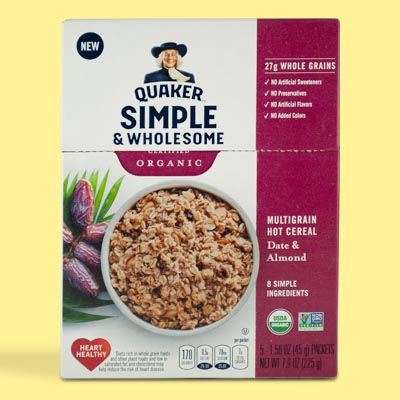
■ Quaker Simple & Wholesome Organic Date & Almond. The new “multigrain hot cereal” (oats, barley, and amaranth) is dotted with plenty of chopped dates for sweetness, so only half a teaspoon of its sugar is added.
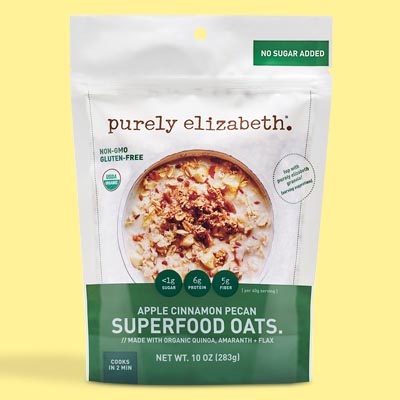
■ Purely Elizabeth Superfood Oats. “Superfood” means that Liz adds fine-but-not-super quinoa and amaranth to her oats. The Cranberry Pumpkin Seed gets a touch of added sugar from the apple juice concentrate in its dried cranberries. Other flavors have no added sugars.
■ Trader Joe’s Oatmeal cups. Our favorite: the Tart Cherry, Chia & Pumpkin Seed adds only enough sugar to sweeten its cherries. Stow a cup of it—or the Strawberry Raspberry—in your desk drawer for those rush-out-the-door mornings.
■ Wild Friends Oats and Nut Butter cups. “One of our favorite ways to eat our nut butter is adding it to a warm bowl of oatmeal,” says Wild Friends. Mmm. Simply knead the nut butter packet and drizzle it over the single-serve cup of hot oats.
Expect more calories—around 350 per cup—than other oatmeals, thanks to the nut butter. We liked the Peanut Blueberry and Almond Cranberry. Each has just 2 or 3 grams of added sugars (enough to sweeten its dried berries).
Or hold a spoonful of your own nut butter on the surface of any hot oatmeal until it starts to melt, then drizzle it in.
3. Check the sodium. Most flavored varieties add salt. We flagged hot cereals with more than 100 milligrams of sodium per serving with a salt shaker in our chart. If you’re watching every milligram, start with a plain hot cereal and rely on your own fruit and nuts for flavor.
Click here to see a chart of our Best Bites, Honorable Mentions, and other hot cereals.
Fiber Facts
“As part of a heart-healthy diet, the soluble fiber in oatmeal can help reduce cholesterol,” says Quaker Quick 1-Minute Oats.
True, but oats are no magic bullet. You’d need to eat 5 to 10 grams of viscous (gel-forming) soluble fiber every day to lower your LDL (“bad”) cholesterol by about 5 percent. A cup of cooked oatmeal has 4 grams of fiber, 2 of which are the soluble kind. Oat bran has 3 grams of soluble fiber. (Tip: oat bran is a perfect whole-grain substitute for Cream of Wheat.)
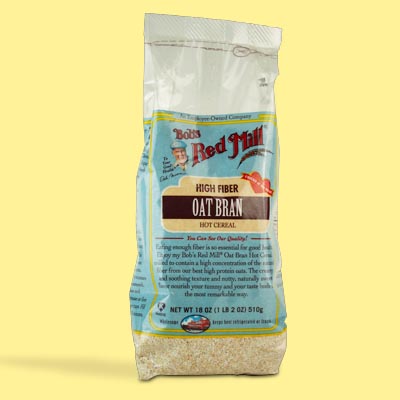
The catch: some companies pump up their oatmeals with extra processed fibers that don’t lower cholesterol. Quaker High Fiber Instant Oatmeal, for example, provides “40% of your daily fiber needs” (10 grams). But that’s largely thanks to added maltodextrin. Think Thin Protein & Fiber Hot Oatmeal adds chicory root.
The Food and Drug Administration counts both ingredients as fiber, but the agency hasn’t approved either to lower cholesterol or—as many people expect—to keep you feeling full for longer or to help you stay regular.
Peddling Antioxidants
“Instant oatmeal with ANTIOXIDANTS,” says Quaker Blueberry Cranberry Oatmeal. “A good source of vitamins A, C, and E.”
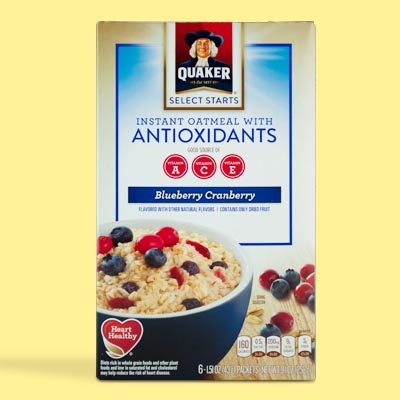
Yes, Quaker adds 10 percent of a day’s vitamins A, C, and E to its oatmeal. Big whoop! Studies that give people much higher doses of those and other antioxidants have largely come up empty.
What’s more, the packets supply more added sugar (two teaspoons) than dried blueberries or cranberries. Ditto for the Green Apple Fig, which has more sugar than dried fig or apple pieces.
But at least both varieties deliver some of the fruits they promise. Quaker’s instant Strawberries & Cream still has strawberry-flavored apples colored with red dye instead of dried strawberries. And the “blueberries” in its instant Blueberries & Cream are dyed blueberry-flavored figs.
Probiotic Push
“Help keep your body and belly healthy,” says Think Thin Protein & Probiotics Hot Oatmeal. “Maximize your day with the hottest trifecta of protein, probiotics and fiber.”
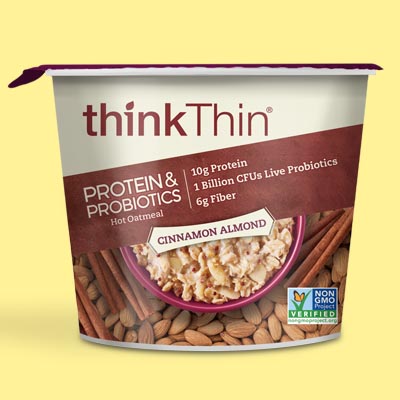
Think Thin adds Bacillus coagulans GBI-30, 6086. So do Earnest Eats Protein Probiotic Oatmeal and Bakery on Main Organic Oats & Happiness with Probiotic Cultures. The probiotic, a patented strain of a hardy microbe surrounded by a tough spore—that’s why it can survive the microwave—is showing up in everything from muffins and granola to ice cream.
Should you count on probiotic oats to keep your “belly healthy”? The evidence for B. coagulans GBI-30, 6086, which was partly funded by the probiotic’s manufacturer, is unimpressive (see Jul./Aug. 2017, "Probiotics: What's in a name?").
And don’t be wowed by Think Thin’s protein. The added soy protein isolate boosts the protein to 10 grams per 200-calorie serving (about ¾ cup cooked). You’d get 10 grams of protein from a cup of cooked plain oats plus a half cup of skim milk...for about the same calories.
Some Like it Cold
“Prepare at night,” says Quaker Overnight Oats. “Enjoy in the morning.”
Overnight oats are in. You add your milk to the “fill line,” then cover, refrigerate overnight, and simply stir (don’t heat!) in the a.m. For creamier oats, add two or three tablespoons of plain yogurt, says the label.
But most of Quaker’s half-dozen varieties, like the Raisin Walnut & Honey Heaven or the Cherry Almond & Vanilla, are too sugary for a Best Bite or Honorable Mention. (Both have 2½ teaspoons of added sugars.) And it’s too bad the Unsweetened with Chia Seeds has no fruit.
Solution: divide your own mix of rolled oats, fruit, and nuts or seeds into jars or reusable containers. At around $2 a pop for Quaker’s cups, you’ll save money, too.
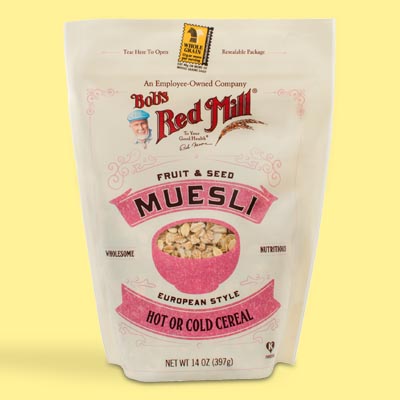
Or take a cue from the Swiss and start with a bag of muesli. Most have little or no added sugars. We love Bob’s Red Mill Old Country Style or Fruit & Seed, which is jam-packed with almonds, raisins, pumpkin seeds, cranberries, blueberries, and cherries. Yum!
Photos (top to bottom): Jolene Mafnas/CSPI, Purely Elizabeth, Jolene Mafnas/CSPI, Think Thin, Bob's Red Mill.
Illustration: Jorge Bach/CSPI.

